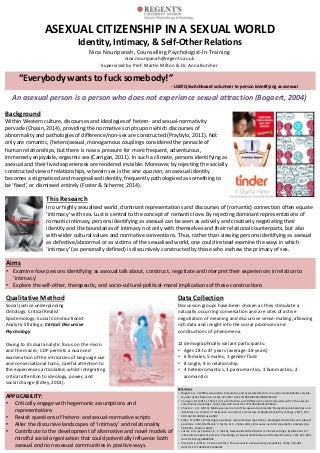Nouripanah.ThesisPoster.DRCII.DCoP.2016
•Als PPTX, PDF herunterladen•
1 gefällt mir•86 views
Melden
Teilen
Melden
Teilen

Empfohlen
Weitere ähnliche Inhalte
Empfohlen
Empfohlen (20)
Product Design Trends in 2024 | Teenage Engineerings

Product Design Trends in 2024 | Teenage Engineerings
How Race, Age and Gender Shape Attitudes Towards Mental Health

How Race, Age and Gender Shape Attitudes Towards Mental Health
AI Trends in Creative Operations 2024 by Artwork Flow.pdf

AI Trends in Creative Operations 2024 by Artwork Flow.pdf
Content Methodology: A Best Practices Report (Webinar)

Content Methodology: A Best Practices Report (Webinar)
How to Prepare For a Successful Job Search for 2024

How to Prepare For a Successful Job Search for 2024
Social Media Marketing Trends 2024 // The Global Indie Insights

Social Media Marketing Trends 2024 // The Global Indie Insights
Trends In Paid Search: Navigating The Digital Landscape In 2024

Trends In Paid Search: Navigating The Digital Landscape In 2024
5 Public speaking tips from TED - Visualized summary

5 Public speaking tips from TED - Visualized summary
Google's Just Not That Into You: Understanding Core Updates & Search Intent

Google's Just Not That Into You: Understanding Core Updates & Search Intent
The six step guide to practical project management

The six step guide to practical project management
Beginners Guide to TikTok for Search - Rachel Pearson - We are Tilt __ Bright...

Beginners Guide to TikTok for Search - Rachel Pearson - We are Tilt __ Bright...
Nouripanah.ThesisPoster.DRCII.DCoP.2016
- 1. ASEXUAL CITIZENSHIP IN A SEXUAL WORLD Identity, Intimacy, & Self-Other Relations Nina Nouripanah, Counselling Psychologist-In-Training nina.nouripanah@regents.ac.uk Supervised by Prof. Martin Milton & Dr. Anna Butcher “Everybody wants to fuck somebody!” - LGBTQ Switchboard volunteer to person identifying as asexual APPLICABILITY: • Critically engage with hegemonic assumptions and representations • Revisit questions of hetero- and sexual-normative scripts • Alter the discursive landscapes of ‘intimacy’ and relationality • Contribute to the development of alternative and novel models of mindful social organisation that could potentially influence both asexual and non-asexual communities in positive ways. An asexual person is a person who does not experience sexual attraction (Bogaert, 2004) Background Within Western culture, discourses and ideologies of hetero- and sexual-normativity pervade (Chasin, 2014), providing the normative scripts upon which discourses of abnormality and pathologies of difference/non-sex are constructed (Przybylo, 2011). Not only are romantic, (hetero)sexual, monogamous couplings considered the pinnacle of human relationships, but there is now a pressure for more frequent, adventurous, immensely enjoyable, orgasmic sex (Carrigan, 2011). In such a climate, persons identifying as asexual and their lived experiences are rendered invisible. Moreover, by rejecting the socially constructed view of relationships, wherein sex is the sine qua non, an asexual identity becomes a stigmatised and marginalised identity, frequently pathologised as something to be ‘fixed’, or dismissed entirely (Foster & Scherrer, 2014). This Research In our highly sexualised world, dominant representations and discourses of (romantic) connection often equate ‘intimacy’ with sex. Lust is central to the concept of romantic love. By rejecting dominant representations of romantic intimacy, persons identifying as asexual can be seen as actively and creatively negotiating their identity and the boundaries of intimacy not only with themselves and their relational counterparts, but also with wider cultural values and normative conventions. Thus, rather than viewing persons identifying as asexual as defective/abnormal or as victims of the sexualised world, one could instead examine the ways in which ‘intimacy’ (as personally defined) is discursively constructed by those who eschew the primacy of sex. Aims • Examine how persons identifying as asexual talk about, construct, negotiate and interpret their experiences in relation to ‘intimacy’ • Explore the self-other, therapeutic, and socio-cultural-political-moral implications of these constructions Qualitative Method Social justice underpinning Ontology: Critical Realist Epistemology: Social Constructionist Analytic Strategy: Critical Discursive Psychology Owing to its dual analytic focus on the micro and the macro, CDP permits a nuanced examination of the intricacies of language use and conversational turns, careful attention to the experiences articulated, whilst integrating critical attention to ideology, power, and social change (Edley, 2001). Data Collection Discussion groups have been chosen as they stimulate a naturally occurring conversation and are sites of active negotiation of meaning and discursive sense-making, allowing rich data and insight into the social processes and constructions of phenomena. 12 demographically variant participants: • Ages 18 to 47 years (average: 28 years) • 6 females, 5 males, 1 gender fluid • 8 single, 4 in relationship • 4 heteroromantics, 3 panromantics, 3 biromantics, 2 aromantics References • Bogaert, A. F. (2004). Asexuality: Prevalence and associated factors in a national probability sample. Journal of Sex Research, 41(3), 279-287. doi:10.1080/0022449049552235 • Carrigan, M. (2011). There’s more to life than sex? Difference and commonality within the asexual community. Sexualities, 14(4), 462-478. doi:10.1177/1363460711406462 • Chasin, C. J. D. (2014). Making sense in and of the asexual community: Navigating relationships and identities in a context of resistance. Journal of Community & Applied Social Psychology, 25(2), 167- 180. doi:10.1002/casp.2003 • Edley, N. (2001). Analysing masculinity: Interpretative repertoires, ideological dilemmas and subject positions. In M. Wetherell, S. Taylor, & S. J. Yates (Eds.), Discourse as data: A guide for analysis (pp. 189-228). London: SAGE. • Foster, A. B., & Scherrer, K. S. (2014). Asexual-identified clients in clinical settings: Implications for culturally competent practice. Psychology of Sexual Orientation and Gender Diversity, 1(4), 422-430. doi:10.1037/sgd0000058 • Przybylo, E. (2011). Crisis and safety: The asexual in a sexusociety. Sexualities, 14(4), 444-461. doi:10.11771363460711406461